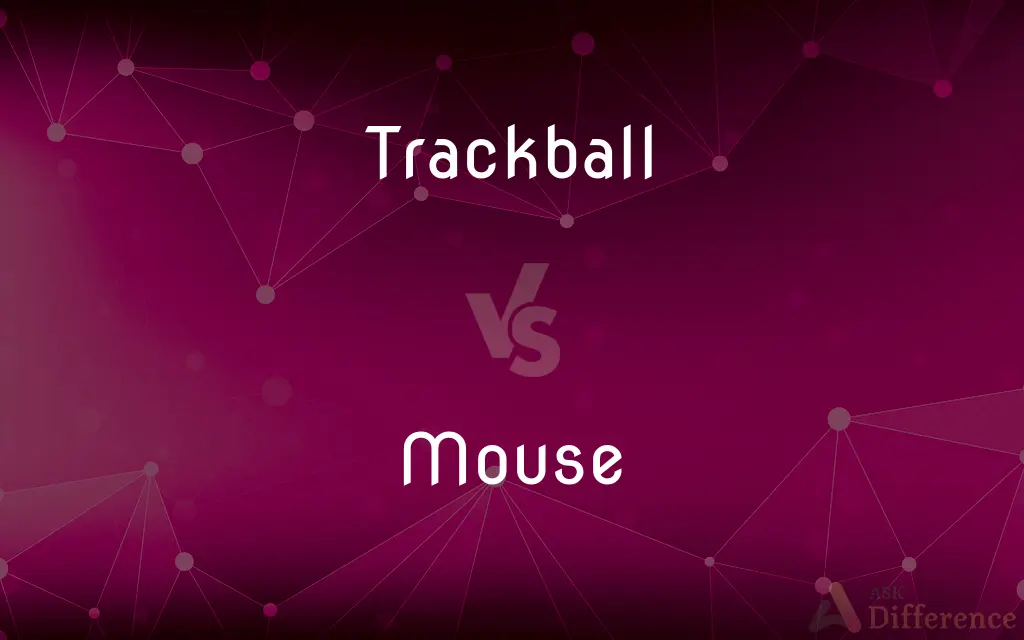Trackball vs. Mouse — What's the Difference?
By Fiza Rafique & Urooj Arif — Updated on April 16, 2024
A trackball controls the cursor with a stationary ball rotated by fingers, while a mouse moves the cursor by sliding on a surface.

Difference Between Trackball and Mouse
Table of Contents
ADVERTISEMENT
Key Differences
A trackball is characterized by a ball that users rotate to control the cursor, making it stationary and space-efficient. On the other hand, a mouse requires physical movement across a surface, thus needing more desk space.
Trackballs often reduce wrist and arm movement, which can be beneficial for users with limited mobility or those seeking to minimize strain. Whereas, using a mouse involves more extensive wrist and arm movements, which can lead to fatigue or repetitive strain injuries.
The precision of a trackball comes from fine control of the ball with fingers or palm, suited for tasks requiring detailed cursor movements. Conversely, a mouse may provide quicker and more fluid movements, preferable in fast-paced computing environments like gaming.
Trackballs typically have a steeper learning curve due to their unique manipulation style. Mice, on the other hand, are more universally used and are often more intuitive for new users.
Maintenance of a trackball involves regular cleaning of the ball and its housing to keep smooth operation, which is different from a mouse that mainly requires surface cleaning and occasional sensor or wheel cleaning.
ADVERTISEMENT
Comparison Chart
Movement
Stationary; ball is manipulated
Slides on a surface
Desk Space Required
Minimal
More, depending on movement
Ergonomics
Reduces wrist movement
Requires wrist and arm movement
Precision
High, with controlled movements
Varies; generally fast and fluid
Learning Curve
Steeper
Easier to adopt
Compare with Definitions
Trackball
A pointing device with a ball set in a socket containing sensors to detect rotation.
The graphic designer preferred a trackball for detailed editing work.
Mouse
A handheld device used to control the cursor on a computer screen, moved physically across a surface.
She used her mouse to quickly scroll through the document.
Trackball
Used for precise control in specialized applications like CAD.
Engineers use trackballs to enhance their control in 3D modeling software.
Mouse
Requires regular maintenance to keep the sensor and moving parts clean.
He cleans his mouse regularly to ensure optimal performance.
Trackball
Features customizable buttons for various functions.
He programmed his trackball's buttons to streamline his workflow.
Mouse
Comes in various designs, including optical and laser for precise tracking.
His new laser mouse worked seamlessly on any surface.
Trackball
Ideal for users with limited desk space.
Compact desks often benefit from the space-saving design of trackballs.
Mouse
Often used for general computing and gaming.
Gamers prefer mice with high DPI for precision and speed.
Trackball
Can be ergonomic, reducing strain on the wrist.
After experiencing wrist pain, she switched to a trackball to alleviate the strain.
Mouse
Can be wired or wireless, providing flexibility in setup.
He opted for a wireless mouse to reduce desk clutter.
Trackball
A trackball is a pointing device consisting of a ball held by a socket containing sensors to detect a rotation of the ball about two axes—like an upside-down mouse with an exposed protruding ball. Users roll the ball to position the on-screen pointer, using their thumb, fingers, or commonly the palm of the hand while using the fingertips to press the mouse buttons.
Mouse
A mouse, plural mice, is a small rodent. Characteristically, mice are known to have a pointed snout, small rounded ears, a body-length scaly tail, and a high breeding rate.
Trackball
A ball mounted in a stationary housing and rotated to control a pointer on a computer screen.
Mouse
A small rodent that typically has a pointed snout, relatively large ears and eyes, and a long tail.
Trackball
(computing) A pointing device consisting of a ball housed in a socket
Mouse
A small handheld device which is moved across a mat or flat surface to move the cursor on a computer screen
The right mouse button
Copy the file with a click of the mouse
Trackball
An electronic device consisting of a rotatable ball in a housing; used to position the cursor and move images on a computer screen;
A trackball is essentially an upside-down mouse
Mouse
A lump or bruise on or near the eye
She touched the mouse under her eye
Mouse
(of a cat or owl) hunt for or catch mice
Female cats are usually much better at mousing than males
Mouse
Use a mouse to move or position a cursor on a computer screen
Simply mouse over any item on the list
Mouse
Any of numerous small rodents of the families Muridae and Cricetidae, such as the house mouse, characteristically having a pointed snout, small rounded ears, and a long naked or almost hairless tail.
Mouse
Any of various similar or related animals, such as the jumping mouse, the vole, or the jerboa.
Mouse
A cowardly or timid person.
Mouse
(Informal) A discolored swelling under the eye caused by a blow; a black eye.
Mouse
Pl. mice or mous·es (mousĭz) Computers A handheld, button-activated input device that when rolled along a flat surface directs an indicator to move correspondingly about a computer screen, allowing the operator to move the indicator freely, as to select operations or manipulate text or graphics.
Mouse
To hunt mice.
Mouse
To search furtively for something; prowl.
Mouse
Any small rodent of the genus Mus.
Mouse
(informal) A member of the many small rodent and marsupial species resembling such a rodent.
Mouse
A quiet or shy person.
Mouse
(computing) (plural mice or, rarely, mouses) An input device that is moved over a pad or other flat surface to produce a corresponding movement of a pointer on a graphical display.
Mouse
(computing) The cursor.
Mouse
(boxing) A facial hematoma or black eye.
Mouse
(nautical) A turn or lashing of spun yarn or small stuff, or a metallic clasp or fastening, uniting the point and shank of a hook to prevent its unhooking or straightening out.
Mouse
(obsolete) A familiar term of endearment.
Mouse
A match used in firing guns or blasting.
Mouse
(set theory) A small model of (a fragment of) Zermelo-Fraenkel set theory with desirable properties (depending on the context).
Mouse
(historical) A small cushion for a woman's hair.
Mouse
Part of a hind leg of beef, next to the round.
Mouse
(intransitive) To move cautiously or furtively, in the manner of a mouse (the rodent) (frequently used in the phrasal verb to mouse around).
Mouse
(intransitive) To hunt or catch mice (the rodents), usually of cats. 12
Mouse
To close the mouth of a hook by a careful binding of marline or wire.
Mouse
To navigate by means of a computer mouse.
Mouse
To tear, as a cat devours a mouse.
Mouse
Any one of numerous species of small rodents belonging to the genus Mus and various related genera of the family Muridæ. The common house mouse (Mus musculus) is found in nearly all countries. The American white-footed mouse, or deer mouse (Peromyscus leucopus, formerly Hesperomys leucopus) sometimes lives in houses. See Dormouse, Meadow mouse, under Meadow, and Harvest mouse, under Harvest.
Mouse
A knob made on a rope with spun yarn or parceling to prevent a running eye from slipping.
Mouse
A familiar term of endearment.
Mouse
A dark-colored swelling caused by a blow.
Mouse
A match used in firing guns or blasting.
Mouse
To watch for and catch mice.
Mouse
To watch for or pursue anything in a sly manner; to pry about, on the lookout for something.
Mouse
To tear, as a cat devours a mouse.
Mouse
Any of numerous small rodents typically resembling diminutive rats having pointed snouts and small ears on elongated bodies with slender usually hairless tails
Mouse
A hand-operated electronic device that controls the coordinates of a cursor on your computer screen as you move it around on a pad; on the bottom of the mouse is a ball that rolls on the surface of the pad;
A mouse takes much more room than a trackball
Mouse
To go stealthily or furtively;
..stead of sneaking around spying on the neighbor's house
Mouse
Manipulate the mouse of a computer
Common Curiosities
How does a mouse work?
A mouse controls the cursor through physical movement across a flat surface, detecting motion via optical or laser sensors.
Can you use a trackball for gaming?
Yes, some trackballs are suitable for gaming, but they might not offer the same speed as high-end gaming mice.
What are the maintenance requirements for a mouse?
Regular cleaning of the sensor and underside to prevent debris accumulation is necessary.
What is a trackball used for?
A trackball is used for precise cursor control, often in specialized fields like graphic design or CAD.
Is a trackball more precise than a mouse?
Trackballs offer precise control, particularly beneficial in tasks requiring fine cursor movements.
Why might a trackball be uncomfortable initially?
Due to its unique operation, a trackball can feel unfamiliar and uncomfortable until the user adapts to the device.
Which is more ergonomic, trackball or mouse?
Trackballs are generally more ergonomic as they require less wrist and arm movement.
Which device is better for limited desk space?
A trackball, due to its stationary design, is better suited for limited desk space.
Are there different types of mice?
Yes, there are various types including optical, laser, and ball mice, each suited to different usage scenarios.
Do trackballs come in different sizes?
Yes, trackballs come in various sizes, affecting the ball's control and user comfort.
How do I clean a trackball?
Cleaning involves removing the ball and wiping the sensors and ball with a soft, damp cloth.
Can I use a mouse on any surface?
Most modern mice work on many surfaces, but performance may vary; mouse pads are recommended for optimal usage.
What should I consider when buying a mouse?
Consider factors like DPI (dots per inch), sensor type, ergonomics, and whether it is wired or wireless.
What are the advantages of wireless mice?
Wireless mice offer greater freedom of movement and reduce desk clutter, although they require battery changes or recharging.
How do I choose between a trackball and a mouse?
Consider your specific needs, desk space, ergonomic requirements, and whether precision or speed is more critical.
Share Your Discovery

Previous Comparison
Peek vs. Glance
Next Comparison
Patriarchy vs. MatriarchyAuthor Spotlight
Written by
Fiza RafiqueFiza Rafique is a skilled content writer at AskDifference.com, where she meticulously refines and enhances written pieces. Drawing from her vast editorial expertise, Fiza ensures clarity, accuracy, and precision in every article. Passionate about language, she continually seeks to elevate the quality of content for readers worldwide.
Co-written by
Urooj ArifUrooj is a skilled content writer at Ask Difference, known for her exceptional ability to simplify complex topics into engaging and informative content. With a passion for research and a flair for clear, concise writing, she consistently delivers articles that resonate with our diverse audience.















































